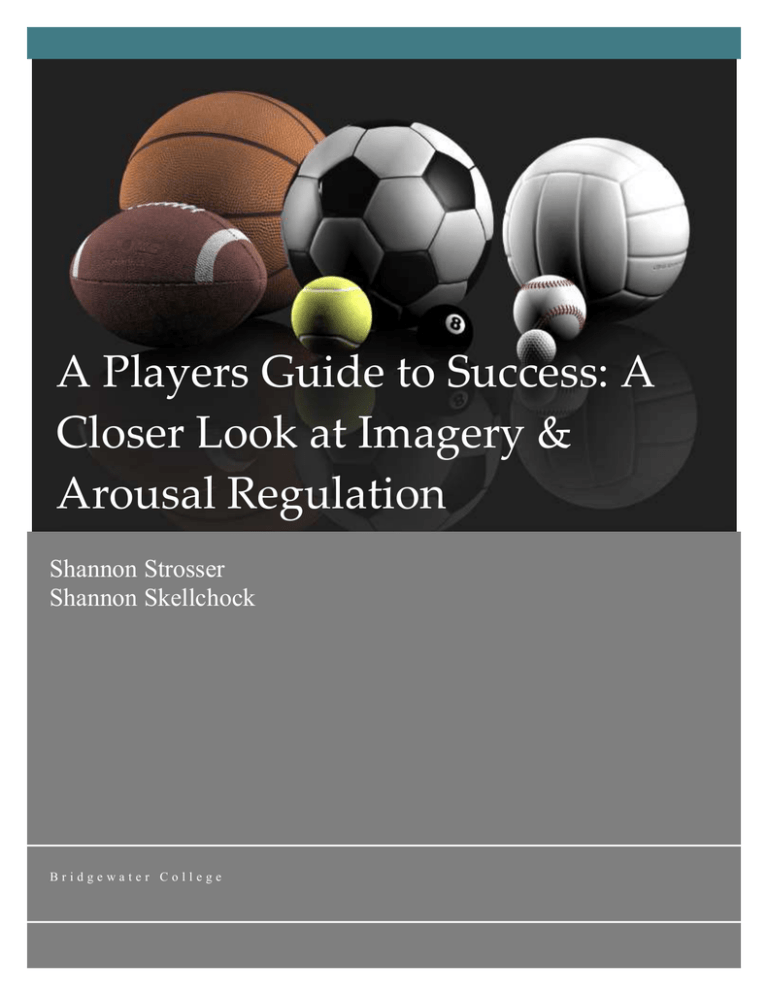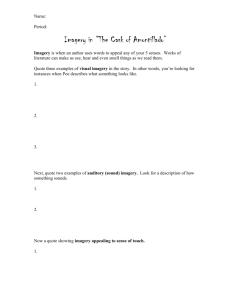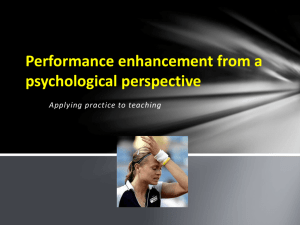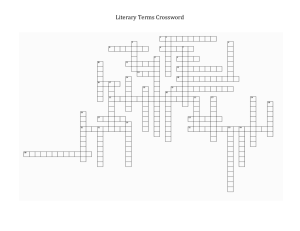File - Shannon Strosser
advertisement

A Players Guide to Success: A Closer Look at Imagery & Arousal Regulation Shannon Strosser Shannon Skellchock Bridgewater College Imagery: Assessment Our clients, college athletes, will be assessed prior to learning the mental skill of imagery by using the Sport Imagery Questionnaire. Rainer Martens, PhD, an author and pioneer in sport psychology developed the Sport Imagery Questionnaire. This questionnaire will assess four important components of imagery, how you see yourself, how clearly you hear the sounds of the activity, how you felt when you did the activity and how aware you were of your mood. To expand, Tony Morris and Peter Terry concluded that as more of the relevant senses are used, the quality of the imagery experience improves and then the effectiveness of imagery for enhancing performance is likely to improve as found in studies completed by Perry & Morris, 1995 as well as Weinberg & Gould, 2007 (p. 296, 2011). The Sport Imagery Questionnaire includes four environments to use imagery in: practicing alone, practicing with others, watching a teammate, and playing in a contest. The questionnaire being used will be uploaded at the end of the document. After completing the questionnaire, you will discover the areas of imagery that are your weakness and that can have improvement. The purpose of this assessment is to allow athletes to become aware of what aspects of imagery they should focus on and to allow their imagery to be individualized. Imagery Strategy A strategy created by Kay Porter is 10 Steps to Writing Your Own Visualization: 1. See, hear and feel yourself performing your event. 2. Write down and dictate into a recorder every detail you can see hear, and feel. 3. Begin with arriving at the event, going through your normal preparatory routine, and the few minutes before you perform. 4. Go into vivid detail about the event and your experience of it, including sounds, colors, smells, the crowd, the weather, the positive feelings in your body and your mental state. 5. Imagine yourself being totally relaxed, confident, powerful, and in complete control of your body and mind. Include your affirmations and keywords that will help you during your real performance. 6. Go through your whole event thinking of each significant point or play. Feel yourself moving smoothly and performing with strength and endurance. 7. After writing your visualization, write statements of relaxation, and remind yourself of your confidence, power, and mental toughness. 8. Now write your visualization in script form. Reread it and edit it. Then dictate yourself or have someone else dictate it and edit it into your recorder. 9. Listen to the recorded visualization for flaws and make changes to the script. When you are satisfied with the script, dictate a progressive relaxation section that you feel will relax you most effectively before the visualization. Then dictate your finished script so that it follows the relaxation section. 10. Listen to the finished tape once a day or at least three or four times a week before an event. Pick a quiet time and place where you won’t be disturbed. Morning or night is usually a good time. Try to stay awake to get the full effect. Sitting up is helpful. It is best to be relaxed and aware. Please do not listen to it while you are driving a motor vehicle. Kay Porter’s 10 Steps to writing your own visualization should be implemented before your season begins during a preseason with your team. Another player or coach should read through the steps as you sit with your eyes close and imagine everything that is going on. Once your visualization script is written and recorded you should replay it throughout the season. Changes can be made to your script if changes affect your play. Imagery can be used before and after practice but limit imagery sessions to about 10 minutes; most athletes have trouble concentrating if anything is longer than that (Weinberg and Gould, p. 314, 2011). This imagery recording may be used before and after competition, during the off-season, during personal time and when recovering from injury. Imagery: Evaluation Now that we have taught you a strategy for creating individual imagery we are going to complete the same survey completed earlier. We will see how your pre-test compare to your posttest after learning the strategies. A little improvement may be seen just within this time period so now you can use these strategies to continuously improve. This questionnaire will give you more insight on what areas of imagery can use improvement and what areas of imagery you excel in. Once the evaluation is completed, the athletes have assessed their progress after learning a strategy to improve imagery. Sports Imagery Questionnaire Arousal Regulation: Assessment At the beginning of every season we are going to assess our teams arousal levels by developing each player’s own self-awareness report. William P. Morgan and John S. Raglin developed the Body Awareness Scale to assess athletes arousal levels, which is a questionnaire to help self identify areas in need for improve to help enhance performance. We will help develop selfawareness of arousal by asking athletes to think back to your best performance and remember how it felt during that time. Then we will have them fill out a questionnaire about performance states based off of their memories. Next we will ask for all our athletes to think back to their worst performance and fill out the same questionnaire. This way we can compare the differences of each performance and make each athlete realize where they struggle with withholding their arousal levels in an optimal zone for performance. Then the athlete knows where they can focus their attention in practicing to control their arousal. Arousal Regulation: Strategy For athletes that have difficulty becoming aroused, they can use psyching-up techniques. This technique involves pre-competition workouts because they have been proven to regulate arousal, according to the Japanese Olympic volleyball team as well as Husak and Hemenway swim coaches. Having a pre-competition workout either right before or 4 hours before game time reduces muscle tension and feelings of anxiety in athletes, which are two major factors that can hurt arousal levels. Under aroused athletes can use this strategy before important competition to help increase arousal levels. A technique for athletes who have a problem of becoming over aroused is progressive relaxation. Edmond Jacobson’s progressive relaxation technique involves an athlete to lie down in a quiet area with neither legs nor arms crossed. While they are in this position they must tense up and relax different muscles in a predetermined order for an hour everyday. After this practice athletes learn to evoke a relaxation response to their entire body or certain parts within minutes. This skill becomes very helpful in situations where athlete needs to regain control over their mind and body. Arousal Regulation: Evaluation Now that we have learned techniques to bettering arousal management keep track of your practice. If you have a tendency of being under aroused then practice pre-competition workouts and find a specific routine that works best for you. If you get over aroused schedule in progressive relaxation into your daily routine until you can active your relaxation response in minutes. After, practicing these techniques you should fill out the checklist of performance states once again to see how your performance was affected by the strategies. Checklist of Performance States Checklist of Performance States Played extremely well 1 2 3 4 5 6 Played extremely poorly Felt extremely relaxed 1 2 3 4 5 6 Felt extremely anxious Felt extremely confident 1 2 3 4 5 6 Felt extremely unconfident Felt in complete control 1 2 3 4 5 6 Had no control at all Muscles were relaxed 1 2 3 4 5 6 Muscles were tense Felt extremely energetic 1 2 3 4 5 6 Felt extremely fatigued Self-talk was positive 1 2 3 4 5 6 Self-talk was negative Felt extremely focused 1 2 3 4 5 6 Felt extremely unfocused Felt effortless 1 2 3 4 5 6 Felt great effort Had high energy 1 2 3 4 5 6 Had low energy References Cox, R. (1994). Sport Psychology: Concepts and Applications. Madison, Wisconsin: WCB Brown & Benchmark. Morris, T., Terry, P. (2011) The New Sport and Exercise Psychology Companion. Morgantown, WV: Fitness Information Technology. Porter, K. (2003) The Mental Athlete: Inner Training for Peak Performance in All Sports. Eugene, OR: Human Kinetics. Stegner, A., Tobar, D.,& Kane, M. (1999). Generalizability of Change Scores on the Body Awareness Scale. Measurement in Physical Education and Exercise Science. 3(3), 125-140 Weinberg, R. S. & Gould, D. (2011). Foundations of Sport & Exercise Psychology. (5th ed.). Champaign, IL: Human Kinetics. (n.d.). Retrieved May 12, 2015, from http://www.againstthegrainsports.com/sports.jpg





